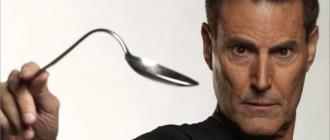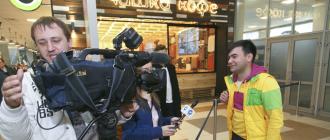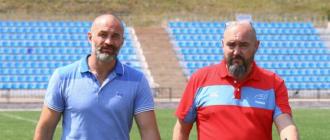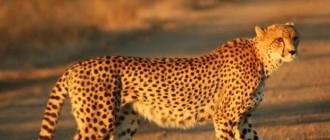Now let's talk about the second basic concept in photography theory - about holding time... What is it, what are the shutter speeds and what depends on the shutter speed set? Let's figure it out.
To understand the essence of exposure in photography, I in simple words I will explain what it is. Excerpt Is the length of time that the camera shutter remains open. That is, during this time, light passes through the lens and hits the camera matrix, drawing an image. Thus, the shutter speed directly affects the amount of light that passes through the lens. That is why exposure, as well as it is the main concept in photography.
The exposure time is indicated as a fraction and denotes a fraction of a second. Long exposure longer than 1 second are expressed as whole numbers. As an example, here's an example of the shutter speed scale used in modern digital photography. Some intermediate values of shutter speeds are missing.
1/1000 (1/1000 s)
1/500 (1/500 s)
1/250 (1/250 s)
1/125 (1/125 s)
2 's, etc.
 Remember the pattern: subject to unchanged shooting parameters, the longer the exposure, the photo will be lighter; if you reduce the shutter speed, the photo will be darker. Therefore, in dark rooms you have to expose long exposure, and on a bright sunny day - a short one. Examples of photos from different meanings shutter speed and the change in the brightness of the photos is illustrated in the picture below.
Remember the pattern: subject to unchanged shooting parameters, the longer the exposure, the photo will be lighter; if you reduce the shutter speed, the photo will be darker. Therefore, in dark rooms you have to expose long exposure, and on a bright sunny day - a short one. Examples of photos from different meanings shutter speed and the change in the brightness of the photos is illustrated in the picture below.
What else depends on holding time when shooting? By changing the shutter speed, you can show movement in the frame - either freeze moving objects in the frame ("freeze" the movement), or vice versa, make moving objects a little blurry. If moving objects enter the frame, then during the moment while the shutter of the camera is open, they have time to move from one point to another.
The faster the shutter speed, the more static the photo becomes. If you expose long exposure, then a moving object will be blurred in the frame in the direction of its movement. This happens because during the exposure time, the moving object has time to be exposed or "appear" at different points in the frame. Therefore, the slow (slow) shutter speed technique is often used for creative shooting.
Examples of shooting with different shutter speeds, see the photos below. This is a classic example of moving water.

Long and short shutter speeds.
You often hear concepts such as "Long exposure" and "short exposure"... Which shutter speed is considered long and which is short? Everything is relative. For example, 1 second. It seems to you that it is very fast, but for the photographer 1 second is long. This exposure is considered long.
 IN normal conditions shooting static objects with normal, working values excerpts are 1/80 - 1/320. Freeze fast motion(splashing water, a running man) is possible at shutter speeds from 1/500 to ultra-short shutter speeds of 1 / 1000-1 / 8000, for example. Shutter speeds from 1/50 to about 1 second are used to display movement- the fluidity of water, for example. Long exposures less than 1/50 is also used for shooting night scenery, freezelight and strobe. Read more about these concepts soon in my articles. Extra long exposures allow you to capture, for example, the movement of stars in the night sky.
IN normal conditions shooting static objects with normal, working values excerpts are 1/80 - 1/320. Freeze fast motion(splashing water, a running man) is possible at shutter speeds from 1/500 to ultra-short shutter speeds of 1 / 1000-1 / 8000, for example. Shutter speeds from 1/50 to about 1 second are used to display movement- the fluidity of water, for example. Long exposures less than 1/50 is also used for shooting night scenery, freezelight and strobe. Read more about these concepts soon in my articles. Extra long exposures allow you to capture, for example, the movement of stars in the night sky.
I will talk in more detail about the little tricks and "tricks" for using the shutter speed in my video courses. Coming soon: Basic Course for Beginner Photographers, stay tuned.
by Thomas Larsen
Many photographers, especially beginners, neglect the possibilities offered by exposure control. Most often, the aperture is set, and the shutter speed is used only for compensation in order to obtain a normal exposure. In this quick photography tutorial, we'll look at how you can apply shutter speed to creativity and some of the mistakes photographers make when choosing a shutter speed.
You should always know what you are shooting, why you are shooting and what result you can expect.
Five classic camera shutter speeds

1. Freeze the movement, or shoot 1/250 s and faster
Using a fast shutter speed helps to get a frame that is sufficiently balanced in sharpness, but makes the picture too static. Any movement in the frame will be frozen. You can fix this by trying to slightly tilt the camera to get a more dynamic photo composition. But the best way- use the shooting technique with wiring, which we will write about later.

The faster the subject moves, the faster the shutter speed should be. For example:
- fast moving cars or animals: 1/1000 s;
- mountain bikes or running people: 1/500 s;
- waves: 1/250 s.
Remember that parts of an object can move very quickly. A striking example of this is a helicopter. The fuselage itself can be frozen at a shutter speed of 1/250, but for the blades, 1/2000 may not be enough. Or, for example, when photographing a girl waving her hair to freeze the ends of her hair, it is also necessary to use shutter speeds of the order of 1/1000 or even less, while the model itself moves relatively slowly.
How do you solve the problem of "smearing"?
You can take many frames, but knowing the laws of physics and the features of recording frames on a memory card, they do it differently. To begin with, about physics: if you throw the ball up, then when will it have the highest speed, and at what point is the lowest? That's right - the largest is when the ball just comes off the hand, and the smallest is at the point where it stops to fly down, i.e. at the peak of its movement along the up-down flight path.
When shooting competitions, where, say, motorcyclists take off on a springboard, the most interesting point is the peak, it is also the "slowest" point in terms of movement. Shooting as many frames as possible is not the best approach to solving the problem. At some point, the camera will simply stop to record everything on a USB flash drive, and at sports competitions, such a delay is fraught with the loss of the best shot.
Use a burst of 2-3 shots instead, but while the main subject is at its peak. This approach provides the photographer with the best chance of obtaining best images due to the fact that the camera will have enough time to record the frame on the memory card without blocking.
2. Shooting with wiring
When shooting with a wipe, when the camera is tracking the movement of the subject, shutter speed plays a very important role. It must be in the range from 1/15 to 1/250 s.

If you have a lot of time, then you can make calculations - what shutter speed is needed to shoot cars moving in a certain area, but in reality everything is a little simpler. If everything in the frame is too blurry, then you need to make the shutter speed faster.

If the frame froze the movement of the car, then an increase in the exposure time is required. And do not forget that 1/125 is a longer period of time than 1/250

For example, some of the values most commonly used by photographers:
- fast moving cars, motorcycles or birds: 1/125 s;
- mountain bikes close to the camera: 1/60 s;
- mountain bikes, animal movement or human work: 1/30 sec.

by Jamey Price 1/60
3. How to use slow shutter speeds
It is also called creative blur - 1/15 s to 1 s.

Here it is necessary to make a small technical digression and remind what a camera is. This is an image fixation tool that allows you to imitate the human eye, the human gaze to some extent. But having created this instrument, a person began to receive unusual effects that are difficult to see in life. Our vision conventionally "makes 25 frames" per second under normal lighting, and we are used to seeing the world as we see it. But the camera, due to the fact that it is different, can show us the world in a different way.
In particular, make an overlay of frames () or, at a slightly slower shutter speed, show the blur of moving objects, turning them into a line.

A similar effect can be observed with your eyes if you quickly turn the flashlight in complete darkness. The dark-adapted eye will perceive a moving spotlight as a line.
A slow shutter speed is used for shooting, for example, a waterfall. Experts in this case, of course, use manual settings and, but you can simply set the shutter speed priority mode (Tv) on the camera.

by Roland Maria, 3 "
Here are some exposures for motion blur:
- fast flow of the waterfall: 1/8 s;
- people walking near the shooting point; waves; slow motion of water: 1/4 s.
In bright light conditions (on a sunny day), it can be difficult to obtain the required shutter speed (below 1/8 s), even by changing the aperture or at low ISO values. To reduce the amount of light, use neutral gray filter(ND), which is exactly for this. In ours you can find neutral gray filters variable density which reduce the amount of light passing through the lens to almost zero and can even turn a sunny day into a night. Well, of course, when using long exposures, the use of or becomes mandatory.
4. Photo with shutter speed from 1 s to 30 s
There are processes that take long time, and shutter speed up to 1 second is no longer enough. These processes differ not only in time, they differ in perception. At shutter speeds from 1 to 30 seconds, all processes that proceed quickly are erased in the frame, only static remains ... soft static. There is a feeling that the world is frozen. Motion disappears again. Only if at shutter speeds of 1/1000 the movement disappears, but a person sees an object that could move, then at a shutter speed of 30 seconds they do not remain.

This effect can only be obtained when using a tripod. At the same time, it can no longer be light, marching, but a stable and heavy model is needed, since even a slight wind will affect the image acquisition. Photographers often use a simple technique - they suspend an additional weight from a tripod, and most often this weight is used in field conditions serves as a working photo backpack. On most tripods, you can see a hook underneath for hanging the load and, accordingly, giving it more stability. Additionally, we recommend that you familiarize yourself with some other working techniques -.
The excerpts that photographers use to create such photos:
- stirring the wind in the foliage of trees: 30 s;
- smooth movement of the sea surface: 15 s;
- fast moving clouds: 8 s;
- waves with preservation of some details: 1 s.
If you plan to shoot before sunrise or after sunset, be prepared for the light to change very quickly, so you will have to change the aperture (or use a faster or slower shutter speed).
5. Shooting at night - shutter speed over 30 s
Shooting at night assumes very little light. Consequently, many photographers have a desire to increase the value, which most often leads to an increase in noise, when individual pixels begin to appear much brighter than others.

Leaving the ISO at a minimum and simply setting a slow shutter speed will result in some reduction in image noise.
Most often, astrophotographers face such problems - that is, people who photograph the starry sky. In addition, with long exposures, due to the rotation of the Earth, an effect arises when the stars line up in a round dance.

In order to avoid this, special equatorial mounts (tripods for telescopes) are used to compensate for the movement of the Earth.
For example, to photograph the night sky, the following exposure times may be required:
- individual stars or full moon landscapes: 2 min .;
- star tracks: 10 min.
Eliminating errors globally
Hand shake
In addition to the fact that the selected shutter speed should depend on the speed of movement of the subject and the amount of light, we remind you that the phenomenon of blur from natural shake of hands also affects the shutter speed. The longer the focal length of the lens, the faster the shutter speed should be. You can approximately calculate as follows - the focal length in mm corresponds to the shutter speed in fractions of a second. That is, with a 50 mm lens, you can shoot from your hands at a shutter speed of at least 1/50 sec without fear of smearing (unless, of course, you do not dance at this time or ride a tour bus), and for 200 mm it will take 1/200 second.

Even a simple monopod allows you to increase the shutter speed by 1-2 times. The photographer has the opportunity to shoot with longer shutter speeds. A good tripod allows you to photograph at any shutter speed.
The exposure time is a qualitative indicator even at. According to the observations of professional portrait painters at exposure 1/50, portraits are "alive". Longer shutter speeds produce blur, while shorter exposures are too frozen.
Failure to properly use the camera's shutter speed will lead to a stagnant aspiring photographer in creative development. There is no need to be afraid to master the initially difficult for perception. Ask questions, we will look together for answers from advanced and professional photographers.
Shutter speed is the most understandable and obvious of the three factors affecting exposure and can create the most noticeable effects. If you don't know much about shutter speed, you may end up with blurry or blurry photos. This tutorial teaches you how to choose the right shutter speed for different situations and how to use it to create creative effects.
Step 1 - What is shutter speed in photography?
Without going into unnecessary details about how the shutter works, we can say that shutter speed is the time at which the shutter opens. If you use a shutter speed slower than a certain one, you will get blurry pictures in most cases. The shutter speed controls the "stops" of the exposure in the same way as the aperture, only much simpler. since the dependence in this case is directly proportional. For example, to halve the exposure, you need to halve the shutter speed, say, from 1/200 to 1/400 of a second.
Step 2 - Motion Blur and Freeze.
Provided that you are not taking blurry photos for creative effect, you will need to choose a shutter speed that is fast enough (high shutter speed) to prevent blurry images. Blurring also depends on the focal length of the lens. A telephoto lens requires a faster shutter speed because even the slightest camera movement will be amplified by the lens. A wide-angle lens can handle slower shutter speeds.
Typically, the average person can take a sharp, blur-free picture if the shutter speed is set to the opposite of the focal length. For example, to take a picture on focal length 30 mm, you need to set the shutter speed no longer than 1/30 sec. If it is longer. the likelihood of getting a blurry or blurry image will increase significantly. However, it's worth noting that this applies to a full-frame camera. if the camera sensor is smaller, then the shutter speed should be shortened by the crop factor factor. For example, for a crop factor of 1.5, the shutter speed will be 1/45 s.
There are exceptions to the rule, for example if the lens has an image stabilization system that allows much slower shutter speeds. As you learn how to use your camera and gradually improve your skills, such as holding the camera correctly in different situations, you will be able to take sharp pictures at slower shutter speeds.
Here's an example of creative motion blur
Freezing
Freezing is much easier to do when shooting. This happens when shooting at very fast shutter speeds (1/500 sec and shorter). This shutter speed freezes any movement, and the photo is clear, without the slightest blur. Personally, I do not like to shoot at such fast shutter speeds, as the photo will turn out to be flat. Instead, when shooting fast moving subjects, I try to include a little movement, otherwise the subject looks unnaturally frozen in place. This is shown in the bottom image, the subject appears to be hovering in the air.

Step 3 - Correct Exposure for Different Situations
Fast shutter speed for telephoto
Since the photo below was taken with a telephoto lens, it was important to use a fast shutter speed (1/500). If you had a tripod, you can use any shutter speed and cable release to prevent camera shake. A tripod allows you to fix the camera still.

Shooting moving subjects in low light conditions.
When you shoot a subject in low light, such as a concert, the artists are more likely to move around the stage. In this case, a contradiction arises between using a fast shutter speed and low light. In this case, you need to use the widest aperture and high ISOs, which allows you to shoot without wiggling.

Step 4. Creative use of shutter speed
Creative blur.
By using a remote shutter release and a tripod to keep the camera steady, you can play with shutter speed and create interesting, blurry, non-standard photos.

Adding a flash to a photo with blur will freeze certain subjects, which means you can move the camera to achieve an artistic effect.

Pan
Panning is a technique where you move the camera to follow a moving object, as a result, the background is blurred and the object is sharp. This image was taken from a moving vehicle that was traveling at the same speed as the train.

Painting with light
To paint with light, you need a long exposure and a light source. This photo was taken at a shutter speed of 30 seconds, during which I moved and shone a flash on the beach houses. This method is great for shooting at night and allows you to add light there. Where would you like to go.

Slow shutter speeds combined with the movement of a small constant light source add graffiti to the image

Since this photo was taken at night, I used a slow shutter speed and a tripod to get a normal exposure. You can also place the camera on a flat, stationary surface.

This photo demanded long exposure but for a different reason. I had to wait for a passing car to get it in the frame, it took enough time. It took me about half an hour to find the best camera position and shooting angle before I got the final image.
Greetings to all amateur photographers! Today in the heading "Theory of photography" we will take a closer look at one of the components of exposure, namely shutter speed, find out what it can be, what it affects in photography and what effects can be achieved if the settings are adjusted correctly.
We also want to draw your attention to the fact that the material below can be useful when creating a photo for a project.
So let's get down to studying.
A camera shutter is like a shutter that opens to allow light to begin exposure and then closes to complete it. As a result, the snapshot does not display a moment, but a certain interval of time. The term is used to describe this interval "excerpt"(exposure duration).
The shutter speed is calculated in fractions of a second: for example, 1/30 s, 1/60 s, 1/125 s, 1/250 s. Only the denominator is displayed on the screen of many cameras - "60", "125", "250". Often, long exposures are displayed as a number with quotation marks - 0 "8, 2" 5. There is also a standard set of excerpts. 1, 1/2, 1/4, 1/8, 1/15, 1/30, 1/60, 1/125, 1/250, 1/500, 1/1000, 1/2000, 1/4000 s ... For slower shutter speeds, the camera has a Bulb option — the shutter remains open for as long as the shutter button is pressed.
Short(1/250 sec and faster) shutter speed as if "freezes" any movement, and the photo is clear, without the slightest blur.
In general, shutter speeds of the order of 1/250 - 1/500 are sufficient to capture the movement of a person, but for close-up or extremely fast subjects, shooting may take 1/1000 or 1/4000 of a second.
Fast moving cars or animals: 1/1000 s;
Waves: 1/250 sec.

Long shutter speed makes it possible to normally expose the frame, especially when there is not enough lighting - at dusk, at night. It also allows you to remove many interesting stories... Since at a slow shutter speed there is a possibility of “wiggling” and blurring, it is advisable to use stabilization if it is in the camera or lens. In cases like this good helper will turn out to be a tripod. Turn stabilization off when mounting the camera on a tripod.

Depending on which shutter speed we use when shooting, fast or slow, you can get completely different effects in your photo.
Whenever moving objects appear in the frame, the choice of the shutter speed determines whether the movement will be frozen or cause blur. However, you cannot change the shutter speed by itself without affecting exposure or image quality.
1. When reducing the shutter speed, you need:
Increase ISO speed (possible by-effect: visual noise in the photo)
Close aperture (side effect: depth of field may decrease)
2. With increasing exposure, you need:
Decrease ISO speed (side effect: tripod is indispensable)
Open the aperture wider (side effect: reduced sharpness)
It is very good to have a bulb mode in the camera. In this mode, you can manually set the time for which the shutter will be open. Bulb mode will be useful when night shooting celestial objects, in scientific photography, when the process is filmed, slowed down in time. If you shoot, for example, a night landscape with starry sky on a moonless night with a shutter speed of several hours (with an average aperture value), then the image will show traces of rotation of stars, arcs relative to Pole star... But again, be aware of noise in digital cameras, especially at high ISO values.

To get the correct exposure in the picture, you need to take all this into account and select the values of three values (ISO, aperture, shutter speed) depending on each specific scene, situation.
What should be the exposure for different situations .. Let's consider examples.
Five classic camera shutter speeds:
1. Freeze motion, or shoot 1/250 s or faster.
The faster the subject moves, the faster the shutter speed should be. For example:
Fast moving cars or animals: 1/1000 s;
Mountain bikes or running people: 1/500 s;
Waves: 1/250 sec.

Remember that parts of an object can move very quickly. A striking example of this is a helicopter. The fuselage itself can be frozen at a shutter speed of 1/250, but for the blades, 1/2000 may not be enough. Or, for example, when photographing a girl waving her hair to freeze the ends of her hair, it is also necessary to use shutter speeds of the order of 1/1000 or even less, while the model itself moves relatively slowly.
Using a fast shutter speed helps to get a frame that is sufficiently balanced in sharpness, but makes the picture too static. Any movement in the frame will be frozen.

You can fix this by trying to slightly tilt the camera to get a more dynamic photo composition. But the best option is to use the wiring technique, which will be discussed later.
2. Shooting with wiring.
Shooting with "wiring" is a technique that gives the effect of movement in the picture, while the subject is sharp against a blurred background.

And here endurance plays a very important role. It should be in the range from 1/15 s to 1/250 s. If you shoot at faster shutter speeds, 1 / 500-1 / 1000, the effect of movement will diminish or disappear altogether. Since a fast shutter speed will give the background and the subject equally sharp. Compare these two photos.
|
|
For example, some of the values most commonly used by photographers:
Fast moving cars, motorcycles or birds: 1/125 s;
Mountain bikes close to the camera: 1/60 s;
Mountain bikes, animal movement or human work: 1/30 p.
3. Creative Blur - Shutter speed from 1/15 s to 1 s.
For example, the fast flow of a waterfall: 1/8 s; people walking near the shooting point; waves; slow motion of water: 1/4 s.

In bright light conditions (on a sunny day), it can be difficult to obtain the required shutter speed (below 1/8 s), even by changing the aperture or at low ISO values. To reduce the amount of light, a neutral gray (ND) filter is used, which is exactly what is intended for this. The tripod should not be forgotten here either.

The exposure set also affects the transmission of weather in the picture. You can convey rain in solid lines using shutter speeds of 1/4 s and slower. If you want to "freeze", stop individual snowflakes in flight, set the shutter speed to 1/125 s.

Adding a flash to a photo with blur will freeze certain subjects, which means you can move the camera to achieve an artistic effect.

Slow shutter speeds combined with the movement of a small constant light source add graffiti to the image.

4. Photo with shutter speed from 1 s to 30 s.
There are processes that take a long time, and exposure up to 1 second is no longer enough. These processes differ not only in time, they differ in perception. At shutter speeds from 1 to 30 seconds, all processes that proceed quickly are erased in the frame, only statics remains ... soft statics. There is a feeling that the world is frozen. Motion disappears again. Only if at shutter speeds of 1/1000 the movement disappears, but a person sees an object that could move, then at a shutter speed of 30 seconds they do not remain. This effect can only be obtained when using a tripod.
The Ferris wheel at night, with a long exposure, looks very impressive. To capture it you need wide angle lens... Mount the camera on a tripod, compose the shot and shoot. Since we want the maximum area of the frame to be in focus, it is worth setting the aperture within f / 11-f / 32. When photographing at night, this aperture will require a slow shutter speed. You will have to work in manual mode, or shutter priority mode. The shutter speed should be set to a value from 1 to 30 seconds. Shooting is best done with a timer, cable release or remote control remote control... As a result, you should get a frame with dark skies, clear center of the wheel and blurred lights of the wheel illumination.
Photographing star trails

By shooting with slow shutter speeds, you can achieve beautiful effects that show the movement of the stars across the sky. Such photos can be made much more beautiful with trees and other interesting foreground objects. For this type of shooting, set the shutter speed on the camera to "Bulb" mode and set the aperture to f / 2.8 - f / 4 for optimal results. Activate the shutter button with the remote control. ISO sensitivity should be set to the minimum value in order for the photos to be as sharp as possible and not grainy. After the desired period of time has passed, press the button on the remote control again, thereby completing the process of creating a photo. At the same time, the time should pass at least 15 minutes, and even better, that it would be several hours.
Blurred headlights

Shooting at a slow shutter speed creates a stunning headlight effect. Photographing cars is a great way to learn how to work with long exposures in particular and manual modes in general. You will definitely need a tripod for this kind of shooting, as any shake of the hand will blur the frame. As for the settings, it is advisable to set the aperture to a value of about f / 16, so that most of the frame will be in focus and will be clear. Then you set the shutter speed. The longer you set the shutter speed, the longer the lines from the headlights you get.
Blur sea waves

When photographing the seaside with a slow shutter speed, you will get a beautiful blurred wave effect that looks like fog. For this kind of work, it is best to photograph in the last hour before sunset. You will also need a tripod for this job. For photography, it is recommended to use a wide-angle lens with the smallest aperture opening and focus at infinity. Rotate the camera's mode switch to manual mode, and use a slow shutter speed (5-30 seconds). The longer the exposure, the more seawater will look like fog. To avoid even the slightest blur, use the remote control, cable release or timer.
Determination of exposure

The settings used during night operation will depend on certain factors. If, despite the night time, it is light around, then the shutter speed can be set lower, or the aperture can be closed more. In any case, it is recommended to set the shutter speed to about 1/2 second to create blur effects, which means that using a tripod for a high-quality result is mandatory. If you have little experience of night shooting, then play with the settings and try different variants values for aperture and shutter speed.
Taking pictures at long exposures, important factor to choose a setting, there must be an understanding of what effect you want to achieve. It is necessary to use such an endurance that would be sufficient to achieve this or that result. If the shutter speed is too fast at a wide aperture, the photo may be too overexposed and image details will be lost. When trying to create a trail of headlights, the shutter must be open for at least 1 second. Use Shutter Priority mode and start at a shutter speed of one second to see the result. Then increase the shutter speed to two seconds, and so on, changing the aperture value, then the shutter speed value. Once you do beautiful photo, you will understand it immediately.
In addition to your DSLR or mirrorless camera, you will need a tripod, without it there is practically nothing to do at night. A tripod will allow you to stabilize the camera by making it stable, and this will help prevent blur in pictures. For night photography, your camera must be able to manually set shutter speed and aperture.








